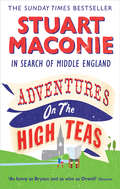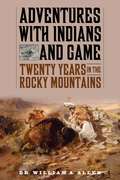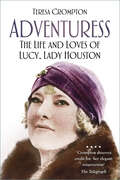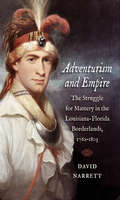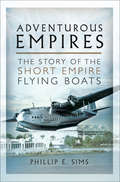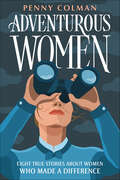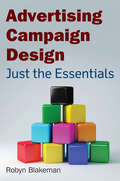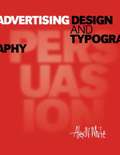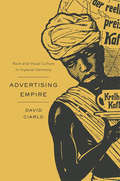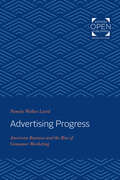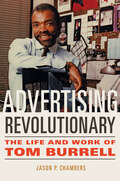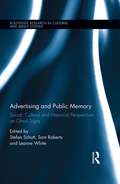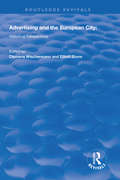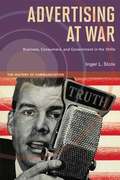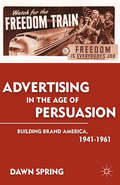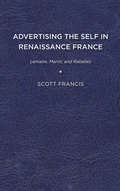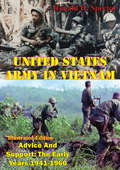- Table View
- List View
Adventures on the High Teas: In Search of Middle England
by Stuart MaconieEveryone talks about 'Middle England'. Sometimes they mean something bad, like a lynch mob of Daily Mail readers, and sometimes they mean something good, like a pint of ale in a sleepy Cotswold village in summer twilight. But just where and what is Middle England? Stuart Maconie didn't know either, so he packed his Thermos and sandwiches and set off to find out...Is Middle England about tradition and decency or closed minds and bigotry? Is it maypoles and evensong, or flooded market towns and binge drinkers in the park? And is Slough really as bad as Ricky Gervais and John Betjeman make out? From Shakespeare to JK Rowling, Vaughan Williams to Craig David, William Morris to B&Q, Stuart Maconie leads the expedition, with plenty of stop-offs for tea and scones, to discover the truth.
Adventures with Indians and Game: Twenty Years in the Rocky Mountains
by William A. AllenAn adventure tale, historical memoir, and hunting journal in a single, enthralling narrative. At the tender age of seven, little William shot his first chipmunk and was “imbued with the spirit of sportsmanship. ” In the following years of his colorful life, Allen wore many hats, living as a tracker, miner, blacksmith, gunsmith, prospector, freighter, and even dentist. Above all, however, was his passion for adventure, the hunt, and his dealings with Native Americans in the waning light of the late nineteenth century in Dakota Territory. A born observer, Allen describes a world that, by the time he wrote his book in 1903, no longer existed. Allen’s accounts of life in the frontier wilderness—hunting otters and grizzly bears, a secondhand reflection on the tragedy of the Battle of the Little Bighorn, witnessing a battle between a rattlesnake and an eagle, and brutal fights and lifelong friendships with Sioux and Crow Indians—reflect a lost era of romantic heroism, untouched nature, and early Western sentiments, both antiquated and modern, toward Native Americans. Not only the thrilling memoir of one man’s life, Adventures with Indians and Game is also a compendium of Western game—how to track, hunt, and kill for entertainment—in a time when hunting for pleasure, rather than food, in the West was a foreign concept. As a pioneer in the field of hunting as a sport in the West, Allen provides a significant historical account of the spirit that spearheaded it. A teetotaler and man of his word, Allen’s narrative voice is strong, straightforward, and immediate, even though he died in 1944. Adventures with Indians and Game is a true-life adventure tale and hunting journal that promises an enthralling and eye-opening read.
Adventuress: The Life and Loves of Lucy, Lady Houston
by Teresa CromptonIn the 1930s Lady Lucy Houston was one of the richest women in England and a household name, notorious for her virulent criticisms of the government. But politics had been far from her mind when, as young Fanny Radmall, she had set out to conquer the world. Armed with only looks and self-confidence, she exploited the wealth and status of successive lovers to push her way into high society. Brushing off scandal, she achieved public recognition as an ardent suffragette, war worker and philanthropist. Having won control of her third husband’s vast fortune, she enjoyed the trappings of wealth – jewellery, couture, racehorses and a luxury yacht – but she wanted more. Seeking influence in national politics, Lady Houston financed the first flight over Mount Everest, backed secret military research, and facilitated the development of the Spitfire aircraft. Engaging with famous contemporaries such as Winston Churchill and Oswald Mosley, Lucy sought her own public voice and so purchased a newspaper. Seeking to expose the Prime Minister as a Soviet agent and promote Edward VIII as England’s dictator, Lucy was loved as a patriot but loathed as a troublemaker. Adventuress draws upon hitherto unpublished archival material to reveal how Lucy Houston achieved her fame and fortune, and how she exploited them.
Adventurism and Empire: The Struggle for Mastery in the Louisiana-Florida Borderlands, 1762-1803
by David NarrettIn this expansive book, David Narrett shows how the United States emerged as a successor empire to Great Britain through rivalry with Spain in the Mississippi Valley and Gulf Coast. As he traces currents of peace and war over four critical decades--from the close of the Seven Years War through the Louisiana Purchase--Narrett sheds new light on individual colonial adventurers and schemers who shaped history through cross-border trade, settlement projects involving slave and free labor, and military incursions into Spanish and Indian territories. Narrett examines the clash of empires and nationalities from the diverse perspectives of Native Americans and of the competing Spanish, French, British, and Anglo-American forces. In a time of great transition, the Louisiana and Florida frontiers were enmeshed in turbulent international politics and experienced tremors from both the American Revolutionary War and the French Revolution. By demonstrating the pervasiveness of intrigue and subterfuge in borderland rivalries and showing that U.S. Manifest Destiny was not a linear or inevitable progression, Narrett redefines the important role these North American borderlands had in shaping the history of the Atlantic world.
Adventurous Empires: The Story of the Short Empire Flying Boats
by Phillip E. SimsA milestone in twentieth century aviation is brought to life in this chronicle of the Short Empire, the plane that transformed British global transportation.In 1937, the Short Brothers aerospace company introduced the most successful flying-boat airliner ever built. Designed to a specification for Imperial Airways, then Britain’s national airline, the Short Empire flying-boat carried passengers and, more importantly, mail throughout the British Empire. The airliner offered luxurious travel for the privileged few, every journey being an adventure shared by passengers and crew.Short Brothers built forty-two Empires at their factory in Rochester during the late 1930s. This fleet enabled Imperial Airways to expand their network to the furthermost outposts of the British Empire, whilst laying down the principles of scheduled airline operation. During World War II, the Short Empire was adapted for military use as the iconic Sunderland.Adventurous Empires chronicles how this innovative craft was developed and deployed, turning an aviation dream into reality.
Adventurous Prayer (Women of Faith Study Guide Series)
by ZondervanThese topical guides will deal with issues that women wrestle with today: God's Will, Living in Christ, Prayer, and Worry. Reaching an audience across race, socio-economic, denominational, and age boundaries, these guides will enhance the lives of women in America as they empower them in their weekly devotions. The study guides can be used for both individual and group settings. Women are asking good questions about their faith. With our study guides, we want to join them in their quest for knowledge and lead them in finding the answers they are seeking.
Adventurous Women: Eight True Stories About Women Who Made a Difference
by Penny ColmanThe adventures of eight inspiring women of the twentieth century.Mary Gibson Henry risked her life following her passion for new botanical species. During the Civil War, Katharine Wormeley worked aboard hospital ships and helped to save the lives of many sick and wounded soldiers. With a promise and a dollar and a half, Mary McLeod Bethune opened a school for African American girls in Daytona Beach, Florida, in 1904, at a time when schools were segregated. Award-winning author Penny Colman offers a compelling collection of true stories about eight women who were bold enough to confront obstacles and take risks in the pursuit of their goals. This is a book that celebrates the intelligence, fortitude, and courage of women.
Adventurous Women: Eight True Stories About Women Who Made aDifference
by Penny ColmanThe adventures of eight inspiring women of the twentieth century. <P><P> Mary Gibson Henry risked her life following her passion for new botanical species. During the Civil War, Katharine Wormeley worked aboard hospital ships and helped to save the lives of many sick and wounded soldiers. With a promise and a dollar and a half, Mary McLeod Bethune opened a school for African American girls in Daytona Beach, Florida, in 1904, at a time when schools were segregated. <P><P> Award-winning author Penny Colman offers a compelling collection of true stories about eight women who were bold enough to confront obstacles and take risks in the pursuit of their goals. This is a book that celebrates the intelligence, fortitude, and courage of women.
Adversarial Design
by Carl DisalvoIn Adversarial Design, Carl DiSalvo examines the ways that technology design can provoke and engage the political. He describes a practice, which he terms "adversarial design," that uses the means and forms of design to challenge beliefs, values, and what is taken to be fact. It is not simply applying design to politics--attempting to improve governance for example, by redesigning ballots and polling places; it is implicitly contestational and strives to question conventional approaches to political issues. DiSalvo explores the political qualities and potentials of design by examining a series of projects that span design and art, engineering and computer science, agitprop and consumer products. He views these projects-- which include computational visualizations of networks of power and influence, therapy robots that shape sociability, and everyday objects embedded with microchips that enable users to circumvent surveillance--through the lens of agonism, a political theory that emphasizes contention as foundational to democracy. Each of these projects engages one of three categories as a medium--information, robots, and ubiquitous computing--and in each of them certain distinctive qualities of computation are used for political ends or to bring forth political issues. DiSalvo's illuminating analysis aims to provide design criticism with a new approach for thinking about the relationship between forms of political expression, computation as a medium, and the processes and products of design.
Adversarial Design (Design Thinking, Design Theory)
by Carl DisalvoAn exploration of the political qualities of technology design, as seen in projects that span art, computer science, and consumer products.In Adversarial Design, Carl DiSalvo examines the ways that technology design can provoke and engage the political. He describes a practice, which he terms “adversarial design,” that uses the means and forms of design to challenge beliefs, values, and what is taken to be fact. It is not simply applying design to politics—attempting to improve governance for example, by redesigning ballots and polling places; it is implicitly contestational and strives to question conventional approaches to political issues. DiSalvo explores the political qualities and potentials of design by examining a series of projects that span design and art, engineering and computer science, agitprop and consumer products. He views these projects—which include computational visualizations of networks of power and influence, therapy robots that shape sociability, and everyday objects embedded with microchips that enable users to circumvent surveillance—through the lens of agonism, a political theory that emphasizes contention as foundational to democracy. DiSalvo's illuminating analysis aims to provide design criticism with a new approach for thinking about the relationship between forms of political expression, computation as a medium, and the processes and products of design.
Advertisements for Runaway Slaves in Virginia, 1801-1820 (Studies in African American History and Culture)
by Daniel MeadersFirst published in 1997. Routledge is an imprint of Taylor & Francis, an informa company.
Advertising Campaign Design: Just the Essentials
by Robyn BlakemanThe author's step-by-step approach to campaign design dissects the creative process necessary to design a successful integrated marketing communications campaign one topic at a time, creating an invaluable research tool that students and professors alike will refer to time and time again.
Advertising Design and Typography
by Alex W. WhiteThe most comprehensive overview of advertising design strategies on the market today! This unique, comprehensive overview of advertising design strategies, written by a best-selling, award-winning designer, will help students and professionals in advertising, design, and typography understand and use persuasive visual messaging. Design principles such as unity, contrast, hierarchy, dominance, scale, abstraction, and type and image relationships are covered in depth. Readers will also learn how print design compares to television, web, and interactive design, and how to apply each style to create persuasive designs. The extensive section on typography offers essential information on how readers perceive type, typographic history, principles, and practice. Helpful appendices include an extensive glossary, bibliography, and art director's checklist. Complete with more than 1,500 examples and illustrations of outstanding advertising design from around the world, Advertising Design and Typography is a groundbreaking book that will train the reader's mind to see more accurately and more critically-ultimately changing the way designers think and develop visual ideas. Best-selling design author has unique philosophy and expertise 1,500 full-color illustrations showcase outstanding advertising design from around the world Unique comparisons of print, web, TV and other campaigns-which techniques work best? Ideas for forging corporate identity through advertising
Advertising Empire: Race and Visual Culture in Imperial Germany
by David CiarloAt the end of the nineteenth century, Germany turned toward colonialism, establishing protectorates in Africa, and toward a mass consumer society, mapping the meaning of commodities through advertising. These developments, distinct in the world of political economy, were intertwined in the world of visual culture. David Ciarlo offers an innovative visual history of each of these transformations. Tracing commercial imagery across different products and media, Ciarlo shows how and why the “African native” had emerged by 1900 to become a familiar figure in the German landscape, selling everything from soap to shirts to coffee. The racialization of black figures, first associated with the American minstrel shows that toured Germany, found ever greater purchase in German advertising up to and after 1905, when Germany waged war against the Herero in Southwest Africa. The new reach of advertising not only expanded the domestic audience for German colonialism, but transformed colonialism’s political and cultural meaning as well, by infusing it with a simplified racial cast. The visual realm shaped the worldview of the colonial rulers, illuminated the importance of commodities, and in the process, drew a path to German modernity. The powerful vision of racial difference at the core of this modernity would have profound consequences for the future.
Advertising Management
by Larry D Kelley Donald W Jugenheimer Fogarty Klein MonroeThis comprehensive book is designed to serve as a primary text for the Advertising Management course that follows the more general Principles of Advertising course. It can stand alone, or, for instructors who prefer a case-based approach, it can be adopted together with "Cases in Advertising Management" (978-0-7656-2261-7) by the same authors. "Advertising Management" covers a full range of topics for a semester-long course, including financial management, business planning, strategic planning, budgeting, human resource management, ethics, and managing change. There is even a unique section on 'managing yourself' and your own career in advertising. The text includes plentiful figures, tables, and sidebars, and each chapter concludes with useful learning objectives, summaries, discussion questions, and additional resources.
Advertising Progress: American Business and the Rise of Consumer Marketing (Studies in Industry and Society #14)
by Pamela Walker LairdSelected by Choice Magazine as an Outstanding Academic TitleOriginally published in 1998. Drawing on both documentary and pictorial evidence, Pamela Walker Laird explores the modernization of American advertising to 1920. She links its rise and transformation to changes that affected American society and business alike, including the rise of professional specialization and the communications revolution that new technologies made possible. Laird finds a fundamental shift in the kinds of people who created advertisements and their relationships to the firms that advertised. Advertising evolved from the work of informing customers (telling people what manufacturers had to sell) to creating consumers (persuading people that they needed to buy). Through this story, Laird shows how and why—in the intense competitions for both markets and cultural authority—the creators of advertisements laid claim to "progress" and used it to legitimate their places in American business and culture.
Advertising Revolutionary: The Life and Work of Tom Burrell
by Jason P. ChambersThe ad exec who revolutionized the image of Black Americans in advertising Over a forty-year career, Chicagoan Tom Burrell changed the face of advertising and revolutionized the industry’s approach to African Americans as human beings and consumers. Jason P. Chambers offers a biography of the groundbreaking creator and entrepreneur that explores Burrell’s role in building brands like McDonald’s and Coca-Cola within a deeply felt vision of folding positive images of Black people into mainstream American life. While detailing Burrell’s successes, Chambers tells a parallel story of what Burrell tried to do that sheds light on the motivations of advertising creators who viewed their work as being about more than just selling. Chambers also highlights how Burrell used his entrepreneurial gifts to build an agency that opened the door for Black artists, copywriters, directors, and other professionals to earn livings, build careers, and become leaders within the industry. Compelling and multidimensional, Advertising Revolutionary combines archival research and interviews with Burrell and his colleagues to provide a long overdue portrait of an advertising industry legend and his times.
Advertising and Public Memory: Social, Cultural and Historical Perspectives on Ghost Signs (Routledge Research in Cultural and Media Studies)
by Sam Roberts Leanne White Stefan SchuttThis is the first scholarly collection to examine the social and cultural aspects on the worldwide interest in the faded remains of advertising signage (popularly known as ‘ghost signs’). Contributors to this volume examine the complex relationships between the signs and those who commissioned them, painted them, viewed them and view them today. Topics covered include cultural memory, urban change, modernity and belonging, local history and place-making, the crowd-sourced use of online mobile and social media to document and share digital artefacts, ‘retro’ design and the resurgence in interest in the handmade. The book is international and interdisciplinary, combining academic analysis and critical input from practitioners and researchers in areas such as cultural studies, destination marketing, heritage advertising, design, social history and commercial archaeology.
Advertising and the European City: Historical Perspectives (Routledge Revivals)
by Clemens Wischermann Elliott ShoreFirst published in 2000, this volume responds to the rise and spread of advertising throughout Europe and the world in the past one and a half centuries which is breathtaking in its scope and influence, now part of the way we think and live. Historians are only just beginning to understand this process, replacing outmoded theories of manipulation which focused on the advertiser with more sophisticated cultural explanations that centre on the way consumers filter and select messages creating new worlds of perception. The authors of this work find the origins and trace the development of this new world or perception in the modern city: London and Paris, the forerunners, and the cities and larger towns of France, Germany, Belgium and the Netherlands, where advertising created new urban perceptions, leading to new avenues of consumption and altered lifestyles. Advertising is viewed in this work as a new way of perceiving and organising the world of the city-dweller, a visual culture, a way of attaching meaning to things and to words, or rearranging the mental map of modern life.
Advertising at War: Business, Consumers, and Government in the 1940s
by Inger L StoleAdvertising at War challenges the notion that advertising disappeared as a political issue in the United States in 1938 with the passage of the Wheeler-Lea Amendment to the Federal Trade Commission Act, the result of more than a decade of campaigning to regulate the advertising industry. Inger L. Stole suggests that the war experience, even more than the legislative battles of the 1930s, defined the role of advertising in U.S. postwar political economy and the nation's cultural firmament. She argues that Washington and Madison Avenue were soon working in tandem with the creation of the Advertising Council in 1942, a joint effort established by the Office of War Information, the Association of National Advertisers, and the American Association of Advertising Agencies. Using archival sources, newspapers accounts, and trade publications, Stole demonstrates that the war elevated and magnified the seeming contradictions of advertising and allowed critics of these practices one final opportunity to corral and regulate the institution of advertising. Exploring how New Dealers and consumer advocates such as the Consumers Union battled the advertising industry, Advertising at War traces the debate over two basic policy questions: whether advertising should continue to be a tax-deductible business expense during the war, and whether the government should require effective standards and labeling for consumer products, which would render most advertising irrelevant. Ultimately the postwar climate of political intolerance and reverence for free enterprise quashed critical investigations into the advertising industry. While advertising could be criticized or lampooned, the institution itself became inviolable.
Advertising in the Age of Persuasion: Building Brand America 1941–1961
by D. SpringAdvertising in the Age of Persuasion documents and analyzes the implementation of the American strategy of consumerism during the 1940s and 1950s, and its ongoing ramifications. Beginning with World War II, and girded by the Cold War, American advertisers, brand name corporations, and representatives of the federal government institutionalized a system of consumer capitalism which they called free enterprise. In their system, government and business worked together to create consumer republics, democracies based on the mass consumption of brand name goods using advertising across all major media to sell products and distribute information. Many of the free enterprise evangelists believed it represented the fulfillment of America's god-ordained mission. They envisioned an American lead global consumer order supported by advertising based media where the brand took precedence over the corporation that owned it; and advertising, propaganda and public relations were considered the same thing. To support this system, they created a network and process for disseminating persuasive information that survives into the 21st Century.
Advertising the American Dream: Making Way for Modernity, 1920-1940
by Roland MarchandIt has become impossible to imagine our culture without advertising. But how and why did advertising become a determiner of our self-image? Advertising the American Dream looks carefully at the two decades when advertising discovered striking new ways to play on our anxieties and to promise solace for the masses.As American society became more urban, more complex, and more dominated by massive bureaucracies, the old American Dream seemed threatened. Advertisers may only have dimly perceived the profound transformations America was experiencing. However, the advertising they created is a wonderfully graphic record of the underlying assumptions and changing values in American culture. With extensive reference to the popular media—radio broadcasts, confession magazines, and tabloid newspapers—Professor Marchand describes how advertisers manipulated modern art and photography to promote an enduring "consumption ethic."
Advertising the Self in Renaissance France: Lemaire, Marot, and Rabelais (Early Modern Exchange)
by Scott FrancisAdvertising the Self in Renaissance France explores how authors and readers are represented in printed editions of three major literary figures: Jean Lemaire de Belges, Clément Marot, and François Rabelais. Print culture is marked by an anxiety of reception that became much more pronounced with increasingly anonymous and unpredictable readerships in the sixteenth century. To allay this anxiety, authors, as well as editors and printers, turned to self-fashioning in order to sell not only their books but also particular ways of reading. They advertised correct modes of reading as transformative experiences offered by selfless authors that would help the actual reader attain the image of the ideal reader held up by the text and paratext. Thus, authorial personae were constructed around the self-fashioning offered to readers, creating an interdependent relationship that anticipated modern advertising.Distributed for the University of Delaware Press
Advice Among Masters: The Ideal in Slave Management in the Old South (Contributions In Afro-american And African Studies #No. 51)
by James O. BreedenThis collection of documents on slavery is like no other: it portrays plantation slavery from the point of view of the masters. They are in this case those slaveholders who wrote on the ideal in slave manage¬ment for the southern agricultural press during the four decades pre¬ceding the Civil War. Slave management studies were a prominent and frequent feature of the South's farm journals. An extensive sampling of these studies is included here to make readily accessible an important source for the study of slavery.
Advice And Support: The Early Years 1941-1960 [Illustrated Edition]
by Ronald H. SpectorIncludes over 75 maps, photos and plans.The present volume describes the activities of the U.S. Army in Vietnam during World War II, military advice and assistance to the French government during the immediate post-war years, and the advisory program that developed after the Geneva Agreements of 1954. Its scope ranges from high-level policy decisions to low-echelon advisory operations in the field, presented against a background of relevant military and political developments. The author enjoyed access to the official records of the period and examined personal papers, interviews, other documentary sources, and miscellaneous published materials. Useful not only as a study of military assistance but as a view of the Army as an agent of national policy, this volume is a fitting introduction to the overall study of the conflict in Vietnam.
